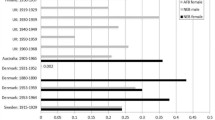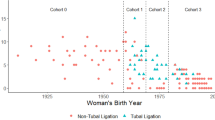Abstract
In this paper intergenerational dimensions of reproductive behavior are studied within the context of the experience of a mid-sized Spanish town just before and during the demographic transition. Different indicators of reproduction are used in bivariate and multivariate approaches. Fertility shows a small, often statistically significant intergenerational dimension, with stronger effects working through women and their mothers than those stemming from the families of their husbands. These effects are materialized mainly through duration-related fertility variables, are singularly absent for variables such as age at first birth or birth intervals, and are much stronger in the case of firstborn daughters than with later siblings. There is a substantial increase in the strength of intergenerational effects during the course of the demographic transition, most visible in age at last birth and duration of reproduction (between women and their mothers), as well as in the effects working through the families of their husbands. These results underscore the on-going importance of biological dimensions of reproduction as well as the way attitudes toward reproduction are taught within the family. The changes identified in this study suggest that the transmission of values and attitudes became more important for reproductive outcomes during this period of demographic modernization.




Similar content being viewed by others
Notes
The percentage of childhood deaths instead of the number of deaths was also used within the model, with almost no difference. The present specification was preferred because of its clarity.
References
Anderton, D. L., Tsuya, N. O., Bean, L. L., & Mineau, G. P. (1987). Intergenerational transmission of relative fertility and life course patterns. Demography, 24, 467–480.
Borgerhoff Mulder, M. (1998). The demographic transition: Are we any closer to an evolutionary explanation. Trends in Ecology and Evolution, 13, 266–270.
Brändström, A., Edvinsson, S., & Rogers, J. (2005). Daughters, mothers and grandmothers: Exploring generational effects on fertility behavior. Paper given at the meeting on “Intergenerational Dimensions of Human Populations in the Past,” Menorca.
Buss, D. M. (1999). Evolutionary psychology: The new science of the mind. Boston: Allyn and Bacon.
Clarke, A. L., & Low, B. (2001). Testing evolutionary hypotheses with demographic data. Population and Development Review, 27(4), 633–660.
Cleland, J. (2001). The effects of improved survival on fertility: A reassessment. In R. A. Bulatao, & J. B. Casterline (Eds.) Global fertility transition (pp. 60–92). Population and Development Review, 27 (supplement). New York: Population Council.
Coale, A. J. (1986). The decline of fertility in Europe since the eighteenth century as a chapter in demographic history. In A. J. Coale, & S. C. Watkins (Eds.) The decline of fertility in Europe (pp. 1–30). Princeton: Princeton University Press.
Ellison, P. T. (2001). On fertile ground. Cambridge, MA: Harvard University Press.
Hastie, T. J. (1992) Generalized additive models. In J. M. Chambers & T. J. Hastie (Eds.) Statistical Models in S. Pacific Grove: Wadsworth.
Imazumi, Y., Nei, M., & Furusho, T. (1970). Variability and heritability of human fertility. Annals of Human Genetics, 33, 251–259.
Johnson, N. E., & Stokes, C. S. (1976). Family size in successive generations: The effects of birth order, intergenerational change in lifestyle, and familial satisfaction. Demography, 13, 175–187.
Kohler, H. P., Rodgers, J. L., & Christensen, K. (1999). Is fertility behavior in our genes? Findings from a Danish twin study. Population and Development Review, 25, 253–288.
Kohler, H. P., Rodgers, J. L., & Christensen, K. (2003). Between nurture and nature: The shifting determinants of female fertility in Danish twin cohorts, 1870–1968. Social Biology, 49(1–2), 76–106.
Langford, C. M., & Wilson, C. (1985). Is there a connection between a woman’s fecundity and that of her mother? Journal of Biosocial Science, 17, 437–443.
Low, B. S. (2000a). Why sex matters. Princeton, NJ: Princeton University Press.
Low, B. S. (2000b). Sex, wealth and fertility: Old rules, new environments. In L. Cronk, N. Chagnon, & W. Irons (Eds.) Adaptation and human behavior: An anthropological perspective (pp. 323–344). New York: Aldine de Gruyter.
McCullagh, P., & Nelder, J. A. (1989). Generalized linear models. London: Chapman and Hall.
Murphy, M. (1999). Is the relationship between fertility of parents and children really weak? Social Biology, 46, 122–145.
Murphy, M. (2006). The role of assortative mating on population growth in contemporary developed societies. In F. Billari, T. Fent, A. Fuernkranz-Prskawetz, & J. Sheffran (Eds.) Agent-based modelling in demography, economics and environmental sciences (pp. 61–84). Heidelberg: Physica Verlag.
Murphy, M., & Knudsen, L. B. (2002). The intergenerational transmission of fertility in contemporary Denmark: The effects of number of siblings (full and half), birth order, and whether male or female. Population Studies, 56, 235–248.
Murphy, M., & Wang, D. (2003). The impact of intergenerationally-transmitted fertility and nuptiality on population dynamics in contemporary populations. In J. L. Rodgers, & H. P. Kohler (Eds.) The biodemography of human reproduction and fertility (pp. 209–228). Boston: Kluwer Academic.
Neel, J. V., & Schull, W. J. (1972). Differential fertility and human evolution. Evolutionary Biology, 6, 363–379.
Pearson, K., Lee, A., & Bramley-Moore, L. (1899). Mathematical contributions to the theory of evolution, VI. Genetic (reproductive) selection: Inheritance of fertility in man, and of fecundity in thoroughbred racehorses. Philosophical Transactions of the Royal Society of London, A192, 257–330.
Pettay, J. E., Kruuk, L. E. B., Jokela, J., & Lummaa, V. (2005). Heritability and genetic constraints of life-history trait evolution in preindustrial humans. Proceedings of the National Academy of Sciences, 102, 2838–2843.
Reher, D. S., & Sanz-Gimeno, A. (2006). Marked from the outset: Season of birth and health during early life in Spain during the demographic transition. Continuity and Change, 21(1), 1–23.
Reher, D. S., & Sanz-Gimeno, A. (2007). Rethinking historical reproductive change: Insights from longitudinal data for a Spanish town. Population and Development Review, 33(4), 703–727.
Rodgers, J. L., & Doughty, D. (2000). Genetic and environmental influences on fertility expectations and outcomes using NLSY kinship data. In J. L Rodgers, D. C. Rowe, & W. B. Miller (Eds.) Genetic influences on human fertility and sexuality: Theoretical and empirical contributions from the biological and behavioral sciences (pp. 85–105). Boston: Kluwer Academic.
Sanderson, S. K. (2001). An evolutionary interpretation of fertility decline: New evidence. Population and Environment: A Journal of Interdisciplinary Studies, 22, 555–563.
Sanderson, S. K., & Dubrow, J. (2000). Fertility decline in the modern world and in the original demographic transition: Testing three theories with cross-national data. Population and Environment: A Journal of Interdisciplinary Studies, 21, 511–537.
Sanz Gimeno, A., & González Quiñones, F. (2001). Las mujeres y el control de la fecundidad. Propuesta metodológica para su identificación duranta la transición demográfica. Revista de Demografía Histórica, XIX-II, 57–78.
Sulloway, F. (1996). Born to rebel. London: Brown.
Voland, E. (2000). Contributions of family reconstitution studies to evolutionary reproductive ecology. Evolutionary Anthropology, 9, 134–146.
Westoff, C. F., & Potvin, R. H. (1967). College women and fertility values. Princeton, NJ: Princeton University Press.
Acknowledgments
Research for this paper received funding from the Fundación Banco Bilbao Vizcaya (BBVA) [BBVA02–11562] and from the Comunidad Autónoma de Madrid [06/0105/97, 06/0070/98, 06/0046/2000, 06/0180/2001, 06/0033/2002]. We have benefited from the helpful suggestions of Mike Murphy, Alan Bittles, Geri Mineau, Fernando González Quiñones, and the participants in the Menorca Seminar in 2005. We would also like to thank María Isabel Sánchez Domínguez for her help in different aspects of this paper.
Author information
Authors and Affiliations
Corresponding author
Rights and permissions
About this article
Cite this article
Reher, D.S., Ortega, J.A. & Sanz-Gimeno, A. Intergenerational Transmission of Reproductive Traits in Spain during the Demographic Transition. Hum Nat 19, 23–43 (2008). https://doi.org/10.1007/s12110-008-9032-6
Published:
Issue Date:
DOI: https://doi.org/10.1007/s12110-008-9032-6




